Abstract
The forces governing the movement of water across the pulmonary capillaries were studied in 39 intact, spontaneously breathing dogs. A situation favoring the net movement of water out of the pulmonary capillaries was created by means of partial pulmonary venous obstruction (left atrial balloon catheter) followed by rapid saline hemodilution. A predetermined difference between pulmonary capillary and plasma colloid osmotic pressures was maintained for periods of 1 to 2 hours. Left atrial (PLA) and plasma colloid osmotic pressures (πpl) were measured directly. The water content of the lungs was measured serially by an indicator-dilution technique, and at autopsy by drying the lungs. The rate of accumulation of lung water was measured in four groups of animals: in three of the groups, the capillary hydrostatic and colloid osmotic pressures were varied; in the fourth group, the right lymphatic duct was obstructed in addition.
The average rate of water accumulation in the lungs varied in a nonlinear way with the level of the capillary hydrostatic-plasma colloid osmotic pressure difference and was unaffected by the level of the capillary hydrostatic pressure. At low levels of PLA — πpl, water accumulated in the lung at an average rate of 0.09 g per g dry lung per hour per mm Hg pressure difference. At higher levels of PLA — πpl the average rate of accumulation was 0.22 g per g per hour per mm Hg ΔP; in most of the experiments in this group water accumulated in the lungs slowly during the first 30 minutes of the test period and more rapidly as the period was extended. Obstruction of right lymphatic duct outflow did not alter the rate of water accumulation. Based on the control data of the present experiments, the pericapillary pressure in normal lungs is estimated to be of the order of — 9 mm Hg in the normal dog lung. The filtration coefficient for the pulmonary capillaries is estimated to be of the order of one-tenth to one-twentieth of that for canine muscle capillaries. The data of the present study indicate that edema formation in lung tissue cannot be defined solely in terms of intravascular forces, but may be governed to a significant degree by changes in pericapillary forces in the pulmonary interstitium.
Full text
PDF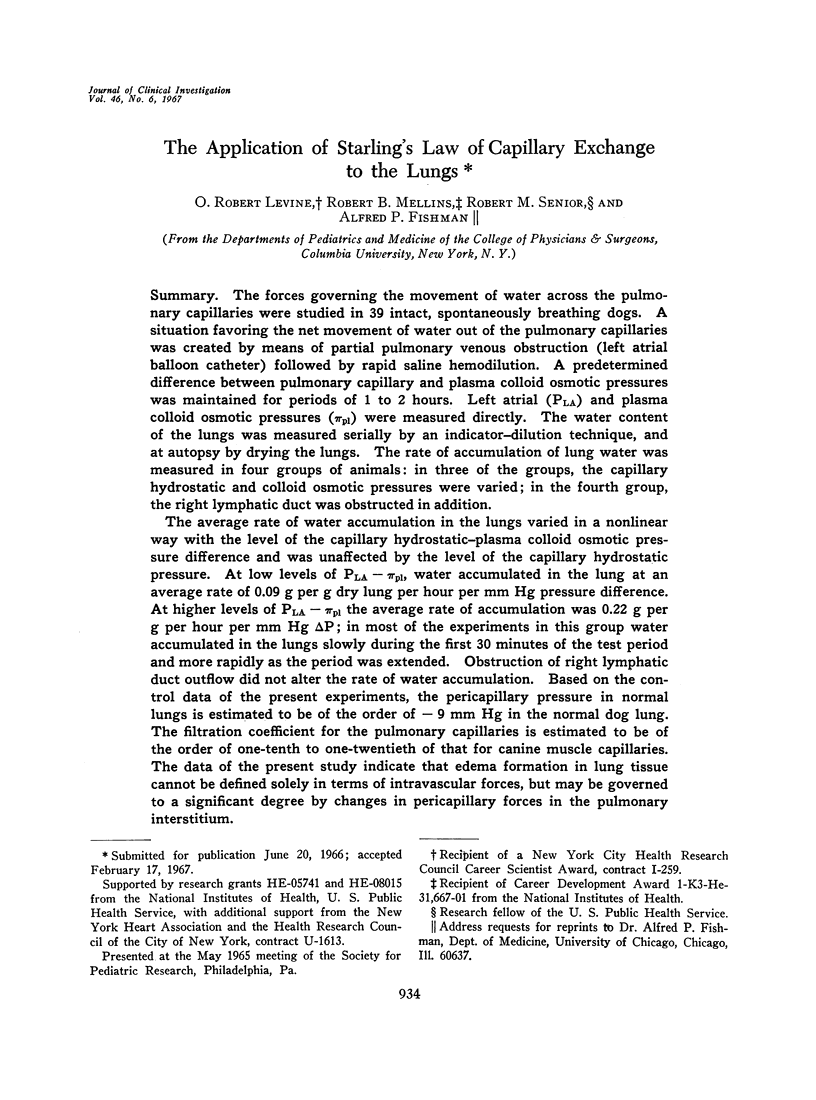
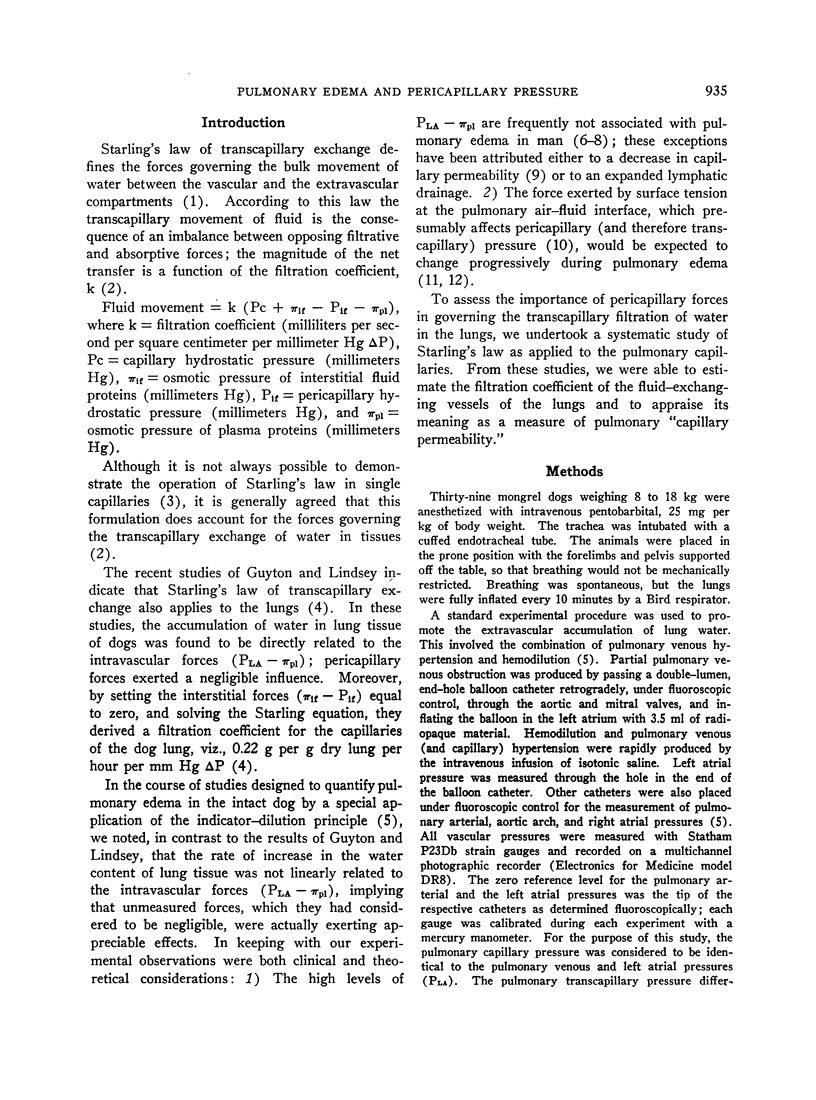
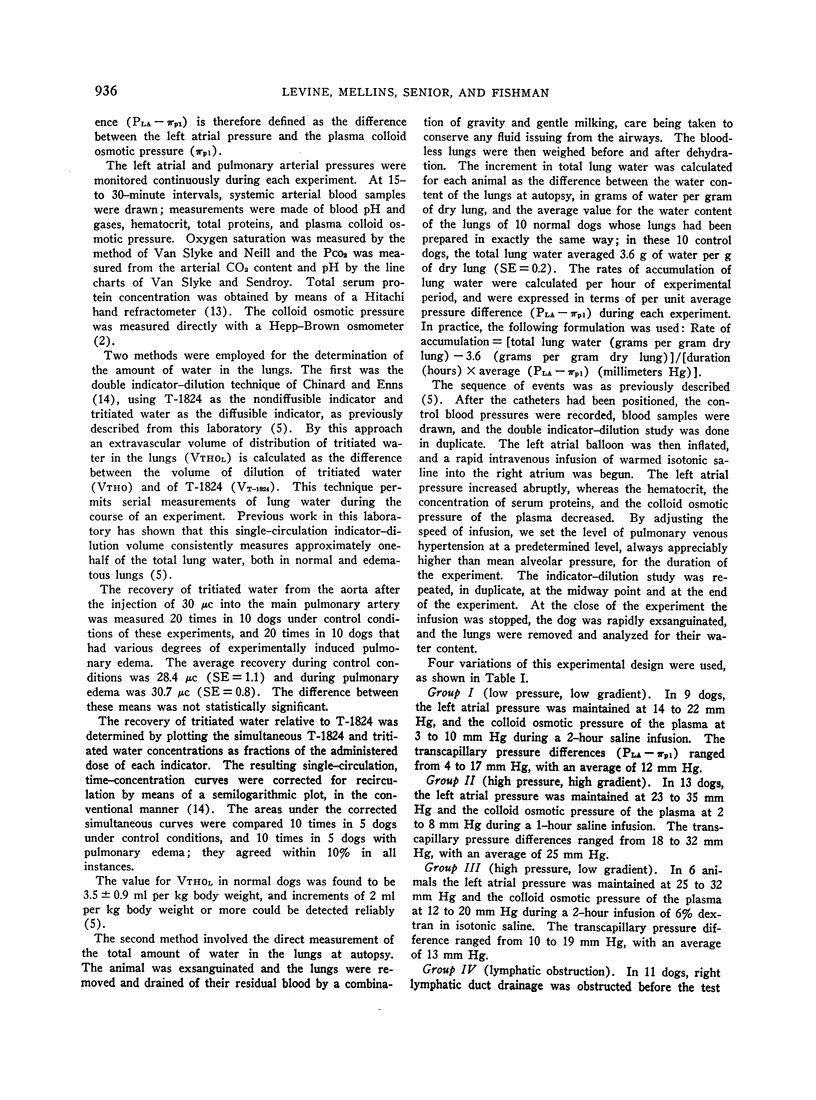
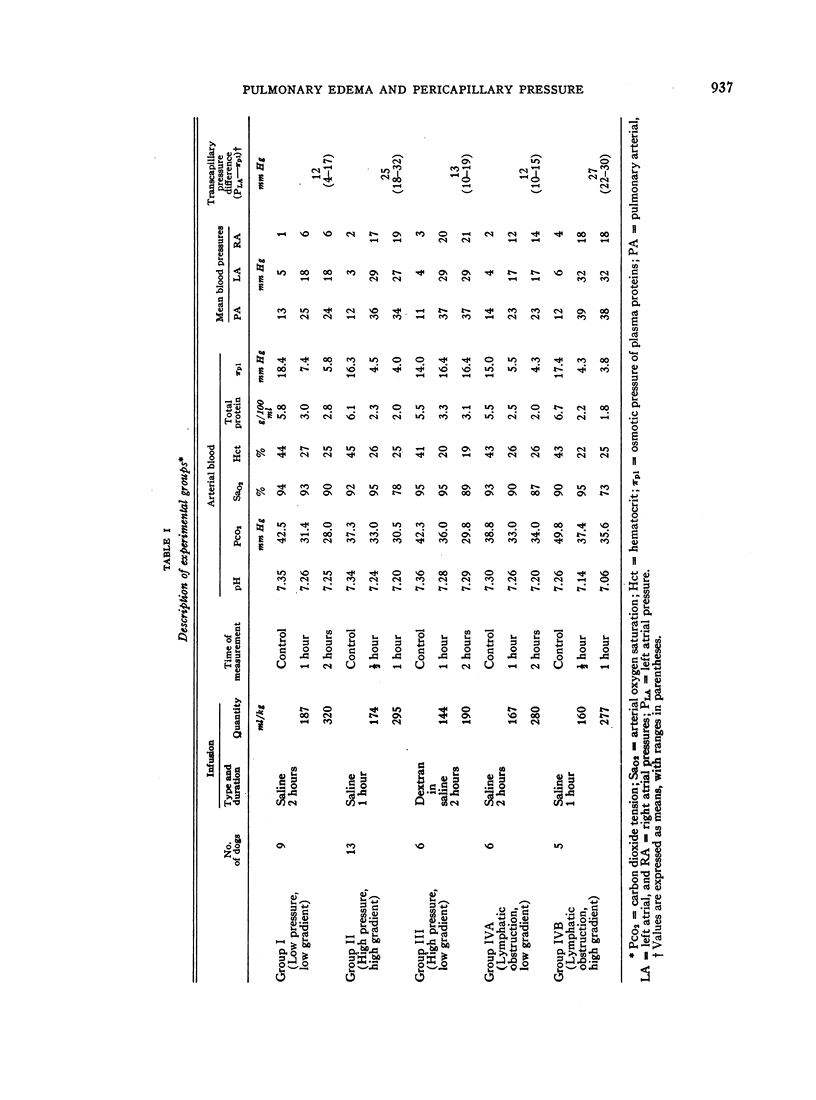
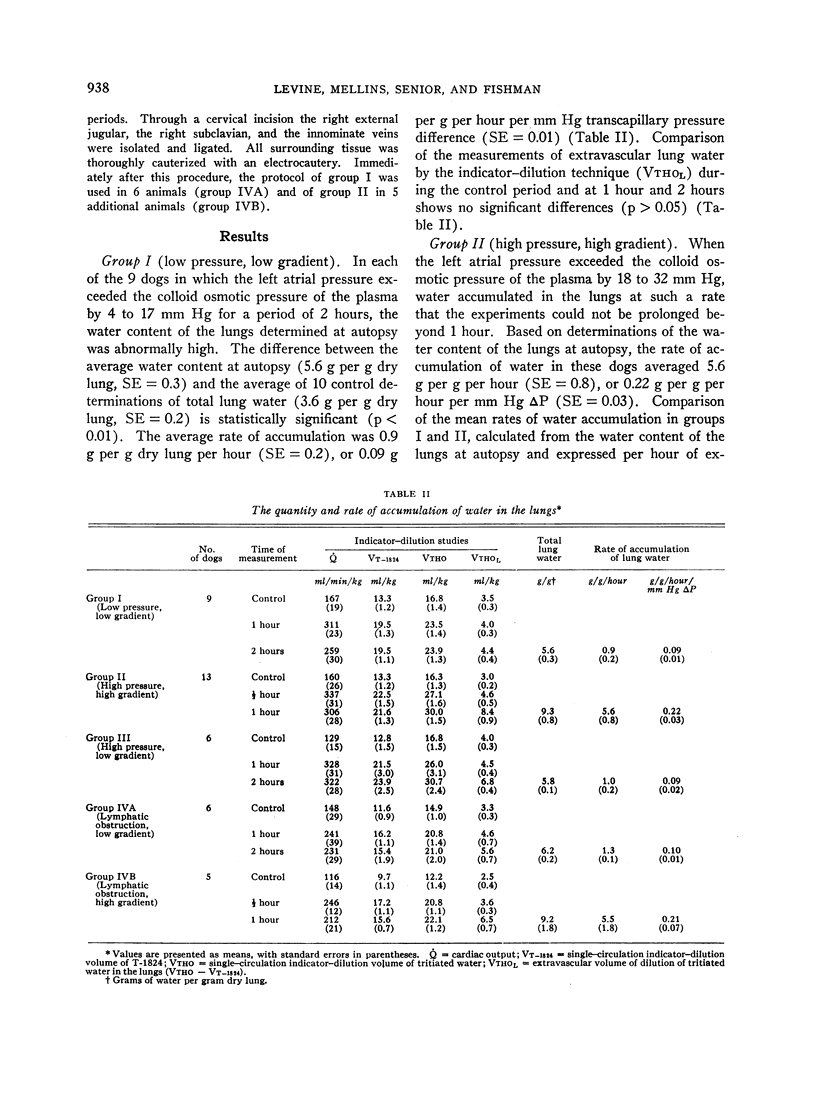
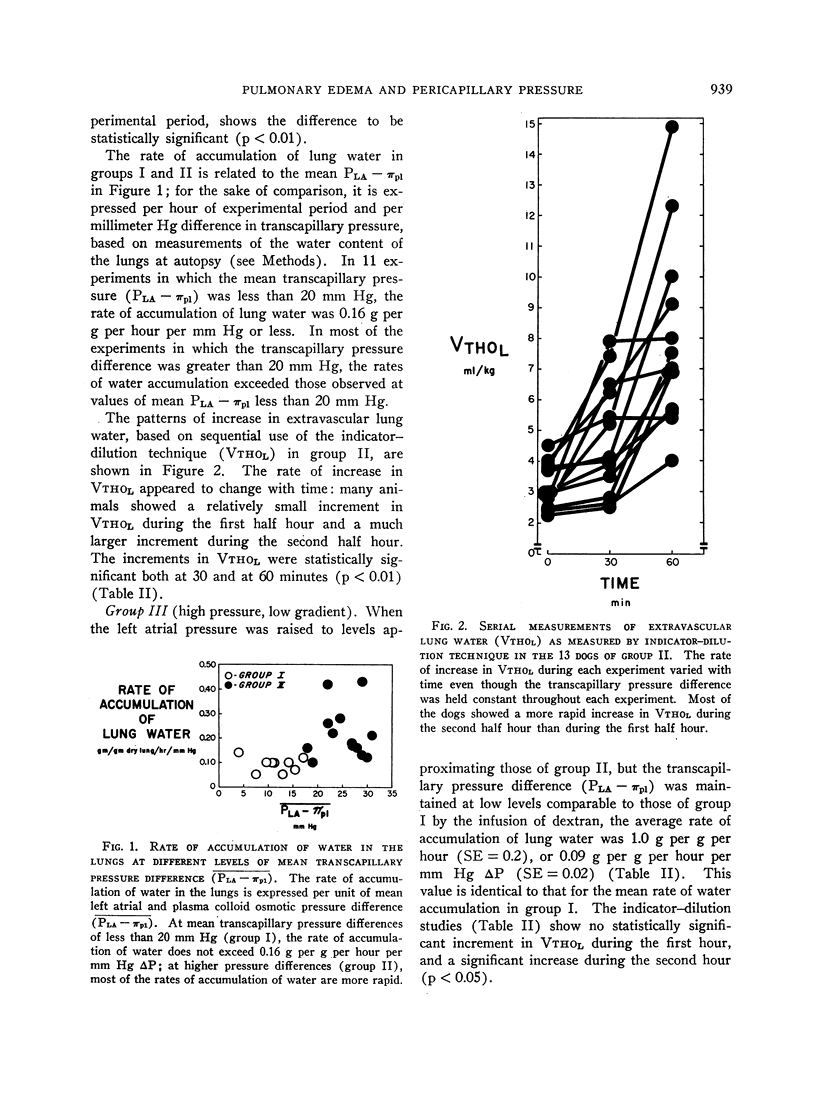
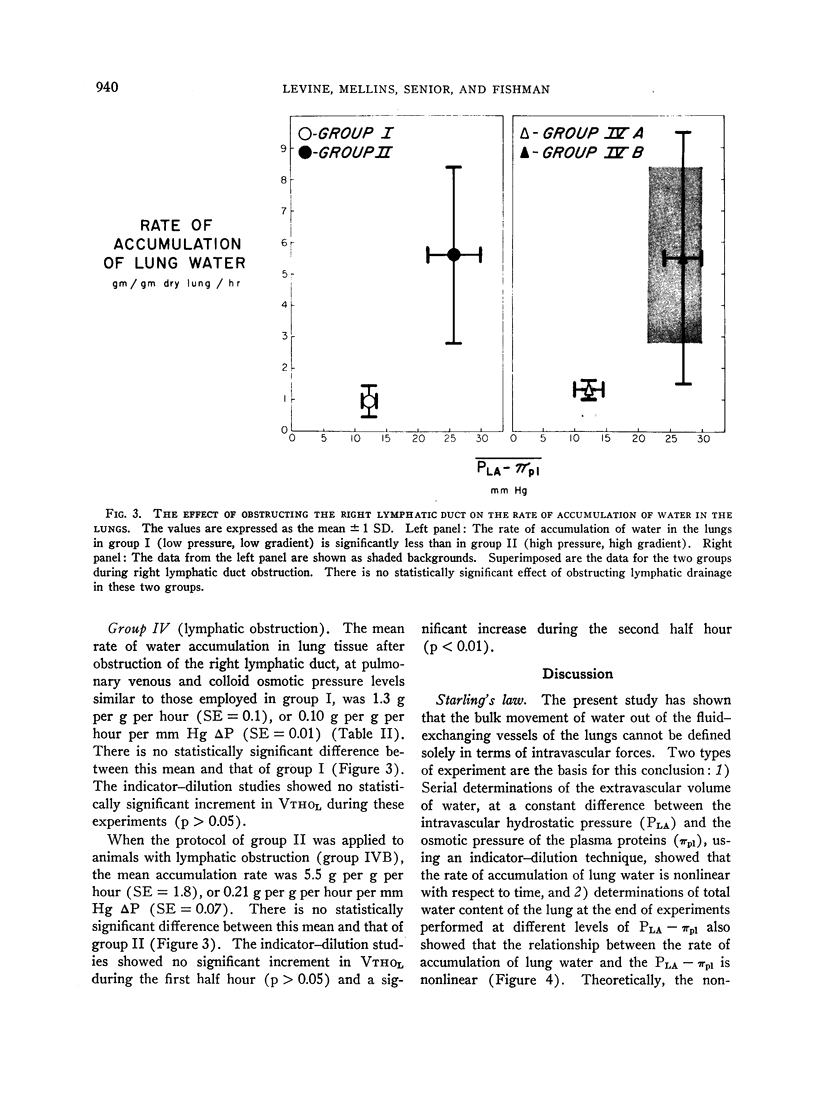
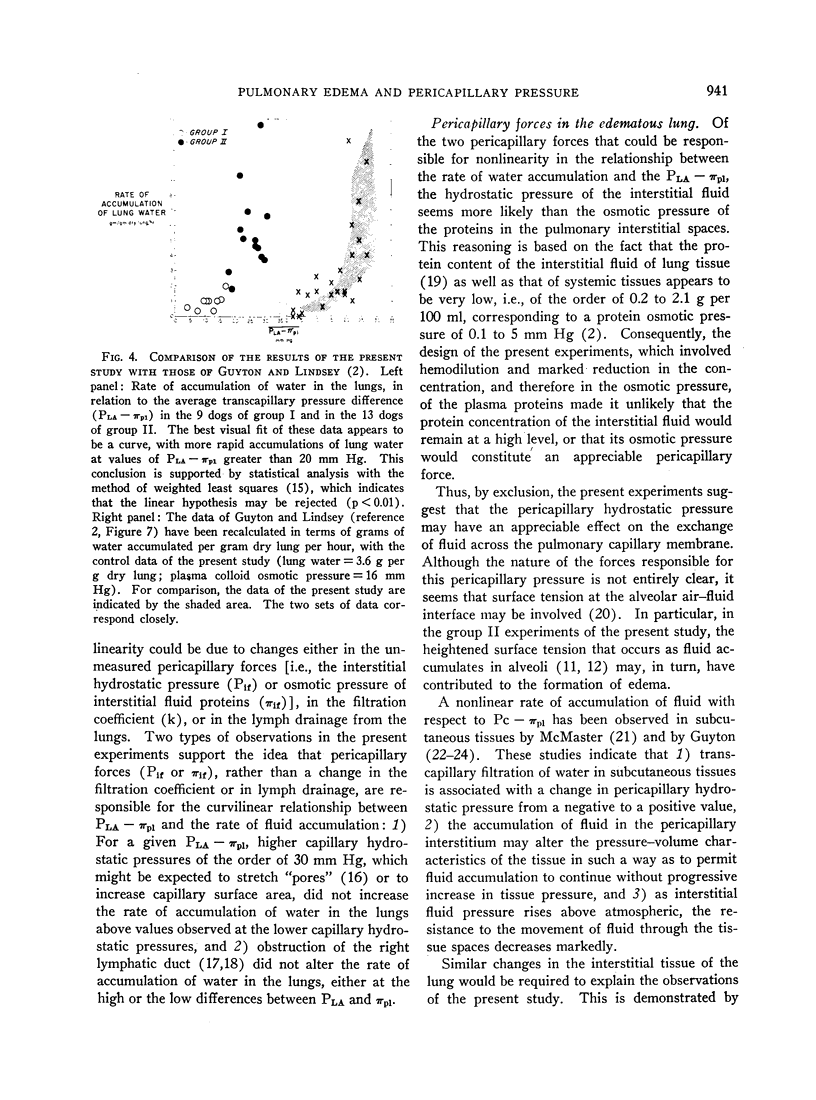
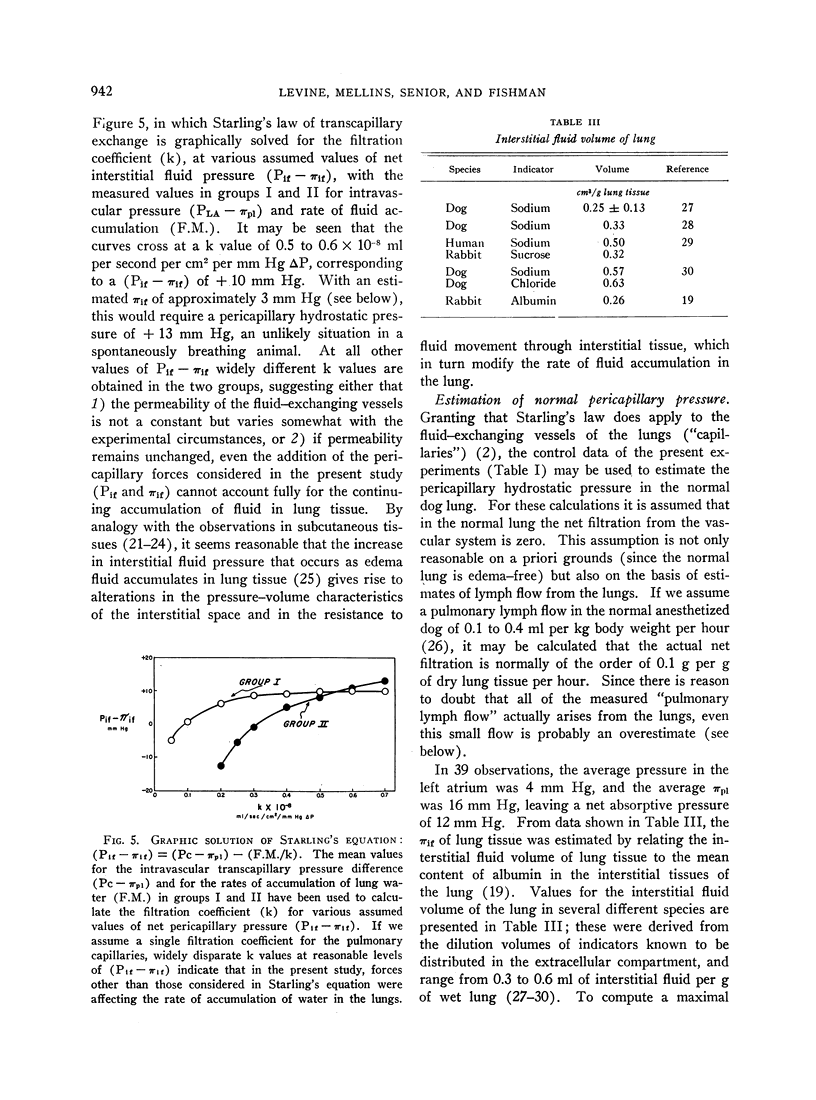
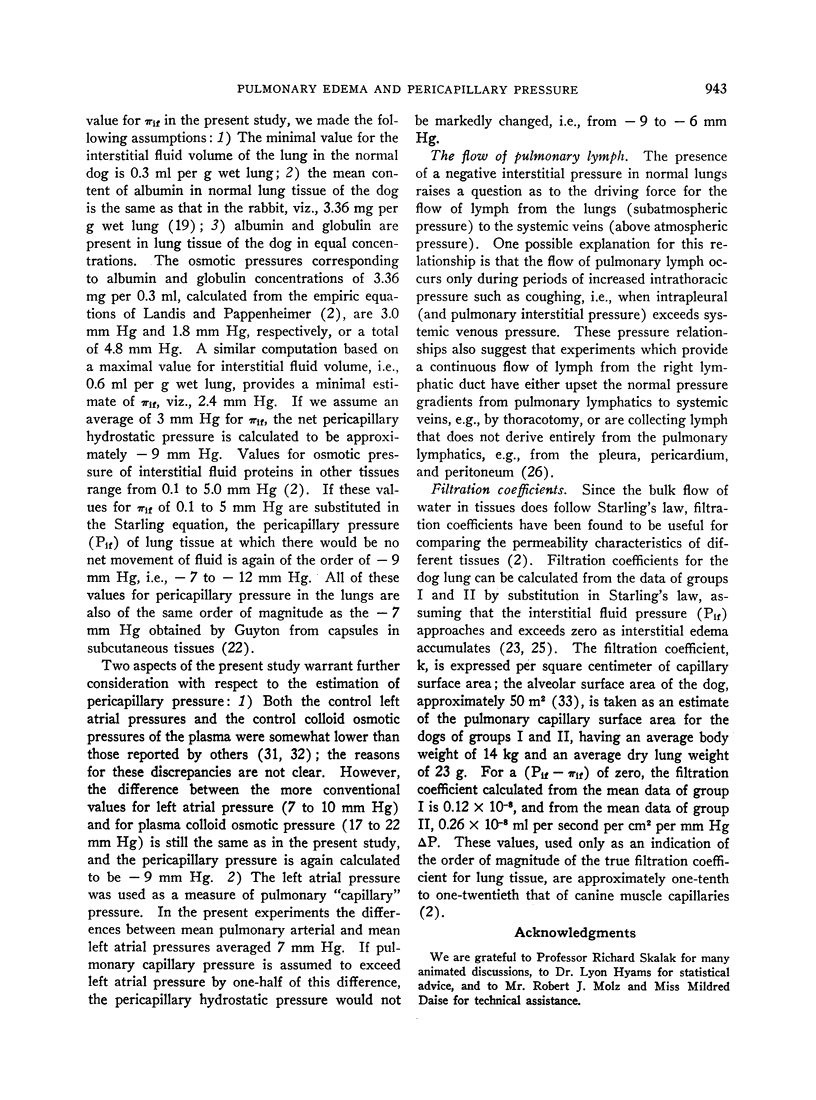
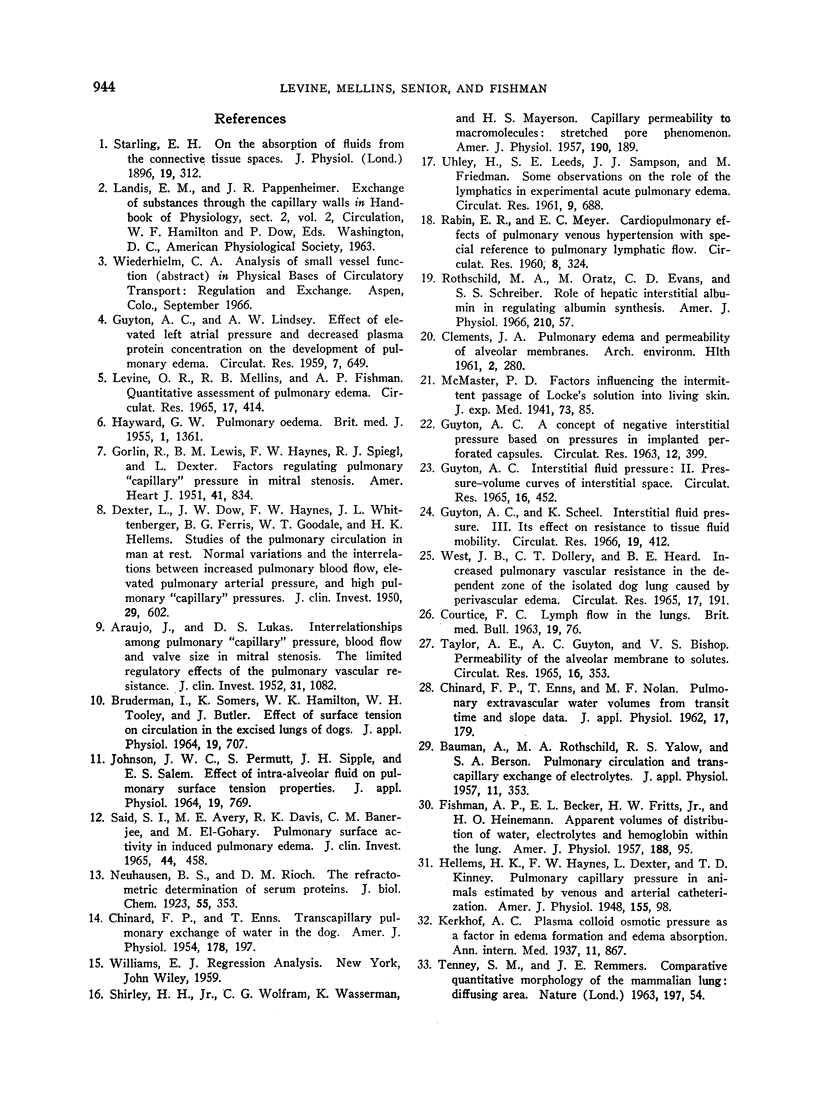
Images in this article
Selected References
These references are in PubMed. This may not be the complete list of references from this article.
- ARAUJO J., LUKAS D. S. Interrelationships among pulmonary capillary pressure, blood flow and valve size in mitral stenosis; the limited regulatory effects of the pulmonary vascular resistance. J Clin Invest. 1952 Dec;31(12):1082–1088. doi: 10.1172/JCI102703. [DOI] [PMC free article] [PubMed] [Google Scholar]
- BAUMAN A., ROTHSCHILD M. A., YALOW R. S., BERSON S. A. Pulmonary circulation and transcapillary exchange of electrolytes. J Appl Physiol. 1957 Nov;11(3):353–361. doi: 10.1152/jappl.1957.11.3.353. [DOI] [PubMed] [Google Scholar]
- BRUDERMAN I., SOMERS K., HAMILTON W. K., TOOLEY W. H., BUTLER J. EFFECT OF SURFACE TENSION ON CIRCULATION IN THE EXCISED LUNGS OF DOGS. J Appl Physiol. 1964 Jul;19:707–712. doi: 10.1152/jappl.1964.19.4.707. [DOI] [PubMed] [Google Scholar]
- CHINARD F. P., ENNS T. Transcapillary pulmonary exchange of water in the dog. Am J Physiol. 1954 Aug;178(2):197–202. doi: 10.1152/ajplegacy.1954.178.2.197. [DOI] [PubMed] [Google Scholar]
- COURTICE F. C. Lymph flow in the lungs. Br Med Bull. 1963 Jan;19:76–79. doi: 10.1093/oxfordjournals.bmb.a070012. [DOI] [PubMed] [Google Scholar]
- DEXTER L., DOW J. W., HAYNES F. W., WHITTENBERGER J. L., FERRIS B. G., GOODALE W. T., HELLEMS H. K. Studies of the pulmonary circulation in man at rest; normal variations and the interrelations between increased pulmonary blood flow, elevated pulmonary arterial pressure, and high pulmonary 'capillary" pressures. J Clin Invest. 1950 May;29(5):602–613. doi: 10.1172/JCI102297. [DOI] [PMC free article] [PubMed] [Google Scholar]
- FISHMAN A. P., BECKER E. L., FRITTS H. W., Jr, HEINEMANN H. O. Apparent volumes of distribution of water, electrolytes and hemoglobin within the lung. Am J Physiol. 1957 Jan;188(1):95–98. doi: 10.1152/ajplegacy.1956.188.1.95. [DOI] [PubMed] [Google Scholar]
- GORLIN R., LEWIS B. M., HAYNES F. W., SPIEGL R. J., DEXTER L. Factors regulating pulmonary capillary pressure in mitral stenosis. IV. Am Heart J. 1951 Jun;41(6):834–854. doi: 10.1016/0002-8703(51)90116-0. [DOI] [PubMed] [Google Scholar]
- GUYTON A. C. A concept of negative interstitial pressure based on pressures in implanted perforated capsules. Circ Res. 1963 Apr;12:399–414. doi: 10.1161/01.res.12.4.399. [DOI] [PubMed] [Google Scholar]
- GUYTON A. C. INTERSTITIAL FLUID PRESURE. II. PRESSURE-VOLUME CURVES OF INTERSTITIAL SPACE . Circ Res. 1965 May;16:452–460. doi: 10.1161/01.res.16.5.452. [DOI] [PubMed] [Google Scholar]
- GUYTON A. C., LINDSEY A. W. Effect of elevated left atrial pressure and decreased plasma protein concentration on the development of pulmonary edema. Circ Res. 1959 Jul;7(4):649–657. doi: 10.1161/01.res.7.4.649. [DOI] [PubMed] [Google Scholar]
- Guyton A. C., Scheel K., Murphree D. Interstitial fluid pressure. 3. Its effect on resistance to tissue fluid mobility. Circ Res. 1966 Aug;19(2):412–419. doi: 10.1161/01.res.19.2.412. [DOI] [PubMed] [Google Scholar]
- HAYWARD G. W. Pulmonary oedema. Br Med J. 1955 Jun 4;1(4926):1361–1367. doi: 10.1136/bmj.1.4926.1361. [DOI] [PMC free article] [PubMed] [Google Scholar]
- JOHNSON J. W., PERMUTT S., SIPPLE J. H., SALEM E. S. EFFECT OF INTRA-ALVEOLAR FLUID ON PULMONARY SURFACE TENSION PROPERTIES. J Appl Physiol. 1964 Jul;19:769–777. doi: 10.1152/jappl.1964.19.4.769. [DOI] [PubMed] [Google Scholar]
- Levine O. R., Mellins R. B., Fishman A. P. Quantitative assessment of pulmonary edema. Circ Res. 1965 Nov;17(5):414–426. doi: 10.1161/01.res.17.5.414. [DOI] [PubMed] [Google Scholar]
- RABIN E. R., MEYER E. C. Cardiopulmonary effects of pulmonary venous hypertension with special reference to pulmonary lymphatic flow. Circ Res. 1960 Mar;8:324–335. doi: 10.1161/01.res.8.2.324. [DOI] [PubMed] [Google Scholar]
- Rothschild M. A., Oratz M., Evans C. D., Schreiber S. S. Role hepatic interstitial albumin in regulating albumin synthesis. Am J Physiol. 1966 Jan;210(1):57–68. doi: 10.1152/ajplegacy.1966.210.1.57. [DOI] [PubMed] [Google Scholar]
- SAID S. I., AVERY M. E., DAVIS R. K., BANERJEE C. M., EL-GOHARY M. PULMONARY SURFACE ACTIVITY IN INDUCED PULMONARY EDEMA. J Clin Invest. 1965 Mar;44:458–464. doi: 10.1172/JCI105159. [DOI] [PMC free article] [PubMed] [Google Scholar]
- SHIRLEY H. H., Jr, WOLFRAM C. G., WASSERMAN K., MAYERSON H. S. Capillary permeability to macromolecules: stretched pore phenomenon. Am J Physiol. 1957 Aug;190(2):189–193. doi: 10.1152/ajplegacy.1957.190.2.189. [DOI] [PubMed] [Google Scholar]
- Starling E. H. On the Absorption of Fluids from the Connective Tissue Spaces. J Physiol. 1896 May 5;19(4):312–326. doi: 10.1113/jphysiol.1896.sp000596. [DOI] [PMC free article] [PubMed] [Google Scholar]
- TAYLOR A. E., GUYTON A. C., BISHOP V. S. PERMEABILITY OF THE ALVEOLAR MEMBRANE TO SOLUTES. Circ Res. 1965 Apr;16:353–362. doi: 10.1161/01.res.16.4.353. [DOI] [PubMed] [Google Scholar]
- TENNEY S. M., REMMERS J. E. Comparative quantitative morphology of the mammalian lung: diffusing area. Nature. 1963 Jan 5;197:54–56. doi: 10.1038/197054a0. [DOI] [PubMed] [Google Scholar]
- UHLEY H., LEEDS S. E., SAMPSON J. J., FRIEDMAN M. Some observations on the role of the lymphatics in experimental acute pulmonary edema. Circ Res. 1961 May;9:688–693. doi: 10.1161/01.res.9.3.688. [DOI] [PubMed] [Google Scholar]
- WEST J. B., DOLLERY C. T., HEARD B. E. INCREASED PULMONARY VASCULAR RESISTANCE IN THE DEPENDENT ZONE OF THE ISOLATED DOG LUNG CAUSED BY PERIVASCULAR EDEMA. Circ Res. 1965 Sep;17:191–206. doi: 10.1161/01.res.17.3.191. [DOI] [PubMed] [Google Scholar]




